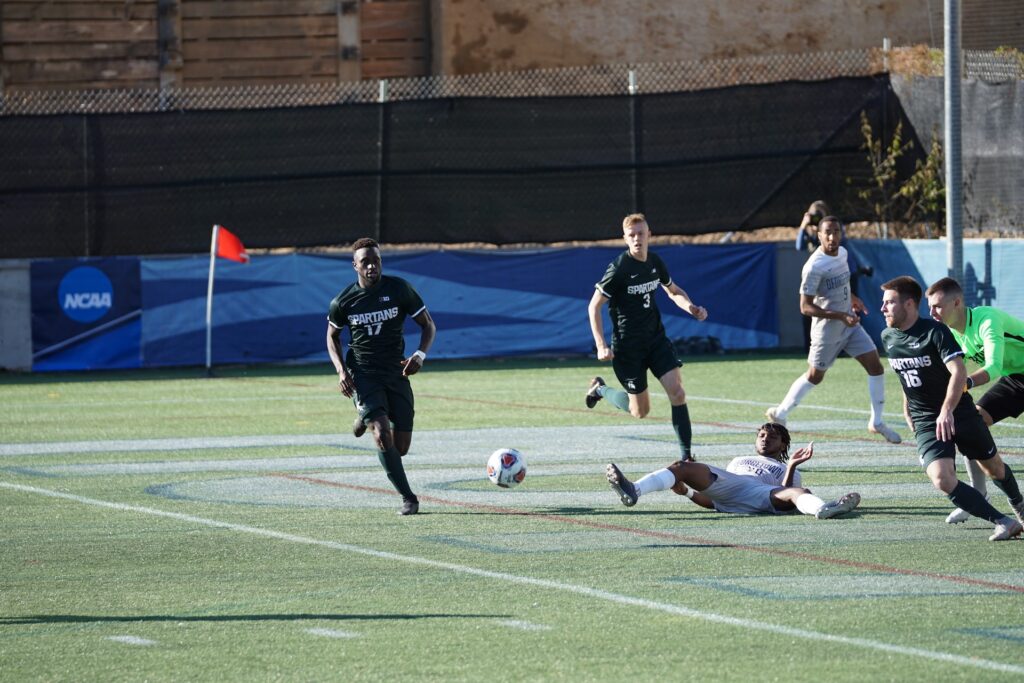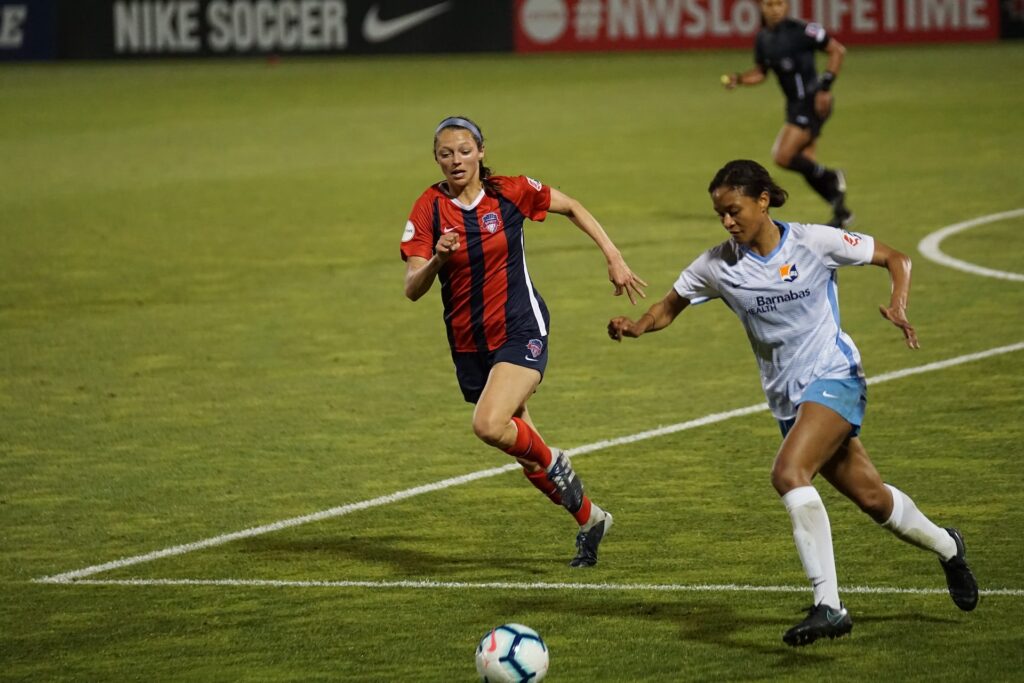Table of Contents
- So, how many players are on a soccer team?
- What are the different positions on a soccer team?
- How many players in a soccer squad?
- Do teams need to play with a goalkeeper?
- What about the other positions?
- How many substitutes are allowed in soccer?
- What’s the minimum number of soccer players on a team?
- Recap: How many players on a soccer team?
One of the most frequently asked questions that new fans of the beautiful game ask, is how many soccer players are on a soccer team?
Of course, it’s a good question, as it’s important to know how many players are tasked with winning the match for a team, how many are on the substitutes’ bench, and how many are left in reserve.
So, without further ado, let’s look at how many players are on a soccer team and what the key positions on the field are.
So, how many players are on a soccer team?
There are eleven players on a soccer team. However, match-day squads usually consist of eighteen players, as seven substitutions can be named. To account for injuries, most soccer squads consist of 25 players in total, enabling the coach to make decisions about which players to pick based on form, performance, injury, and other metrics.
What are the different positions on a soccer team?
There are four primary positions in a soccer team, but each position can then be split into sub-positions depending on the attributes of individual players. Below, we explain the fundamentals of the four main positions on a soccer team:
Goalkeeper

The goalkeeper is the only soccer player on the pitch permitted to use their hands. The job of the goalkeeper is to prevent the other team from scoring, and they spend most (if not all) of the game inside the eighteen-yard box.
Of all the positions on the soccer field, the goalkeeper is the most specialist. Goalkeepers require excellent hand-eye coordination and need to have good positional sense to keep the ball out of the net. It also helps if goalkeepers have good levels of flexibility, helping them reach the ball when it is headed for the corner of the goal.
In a match-day squad, most coaches name two goalkeepers in the team – one in the starting eleven and the other in the dugout, named as a substitute. Should the starting goalkeeper get injured, the substitute goalie will be sent on in their place.
What’s more, while the match-day squad is likely to consist of two goalkeepers, most professional soccer squads have three or even four named goalkeepers to ensure that they cover all bases should injury or poor performance affect the first-choice keeper.
Defender
The next position on the soccer field is that of the defender. As the name suggests, defenders are tasked with preventing the opposition from scoring goals by “defending” their goal. In other words, defenders work together with the goalkeeper to try and keep a clean sheet.
Most teams line up with three or four defenders in their starting eleven, but this can vary significantly depending on the formation employed by the coach. But central defenders on the soccer field tend to be big and strong and are capable of winning tackles and headers.
Full backs – or wide defenders – tend to have some attacking responsibilities, so they’re usually more slight than central defenders. Still, they are primarily responsible for protecting their goal and stopping the opposition from scoring!
As well as the defenders that make the starting eleven, the coach is likely to include one or two defenders on the substitute’s bench, to serve as cover for those that are already on the field.
Otherwise, it’s typical for roughly one-third of an entire soccer squad to be made up of defenders, and they are usually well-coached to ensure that they provide a solid foundation from which the rest of the team can build.
Midfielder
Ahead of defenders on the soccer field are midfielders, given their name because they occupy central positions within the field. Midfielders are responsible for attacking and defending, and they usually have high levels of fitness, as they’re required to support attacks and defensive situations in equal measure.
Central midfielders often control the game and are tasked with making passes to build attacks while offering a shield for the central defenders. The best central midfielders are combative, strong, and able to break up counterattacks and retain possession of the ball for their teammates.
Wide midfielders – commonly known as wingers – are responsible for crossing the ball into the box and creating opportunities for the attacking (offensive) players on the field. Wide midfielders are often fast and skillful and are capable of getting past their opponents to create attacking opportunities for their teammates.
In a match-day squad, there are likely to be a total of 7-8 midfielders, with four starting on the field and another 3-4 on the substitutes bench. Due to the physical demands of the midfield position, it’s common to see these players substituted and replaced with fresh legs!
As for the complete squad, it’s common for approximately one-third of a soccer team to be made up of midfielders, but you will also find that many midfielders are versatile and can serve as defenders or attackers, should the need arise on the field.
Attacker

The fourth and final position on the soccer field is that of the attacker. There are lots of different names for attackers – they’re commonly referred to as forwards – for instance, but they are responsible for putting the ball in the back of the net!
Some people think that attackers have the most important job on the soccer field, but the reality is that every position in soccer is important. All eleven players on the soccer pitch contribute to the team’s success, and of course, every player on the field can score goals for their teams – not only attackers!
Like midfielders and defenders, there are different types of attackers. Commonly, attackers play in the center of the field (known as center forwards), and these are the players tasked with scoring goals. Historically, teams would usually play with two central attackers, but this has changed a lot in recent times, with many teams only employing one central attacker.
This is to accommodate two wider forwards (think Messi and Neymar) who can cause defenders problems for a whole host of reasons! Attackers in soccer often have strength, flair, and excellent finishing skills and are extremely valuable to any soccer team.
Again, approximately one-third of a soccer team is likely to be comprised of attackers, and on a match day, you can expect 2-3 on the field and 2-3 on the substitutes’ bench waiting to take their place if things aren’t going well on the field!
How many players in a soccer squad?
Every competition stipulates how many players a team is allowed to name in their squad, and it’s usually between 22-25 players. At the start of the season or tournament, the coach must submit the squad list to the competition organizers, and they can then name any of these 25 players in the match day squad.
Most competitions, including MLS and the English Premier League, have strict rules in relation to players’ nationalities and the number of youth players that must be in each squad, which is an important consideration for coaches when putting together their squads at the start of the season.
It’s also up to the coach to ensure that the squad achieves a good balance of different players, ensuring that there are enough goalkeepers, defenders, midfielders, and attackers to compete throughout the long and difficult season!
Do teams need to play with a goalkeeper?
Yes! Of all the positions, the goalkeeper is the only one that is stipulated in the laws of the game as essential. A team is not allowed to begin a soccer match without a dedicated goalkeeper. If the goalkeeper gets injured, they must be replaced by another keeper.
If a team doesn’t have another goalkeeper on the bench, they must send an outfield player into goal as a dedicated replacement. Of course, this can cause some serious issues in terms of goal threat, which is why most teams name a goalkeeper on the substitute bench!
What’s more, if a goalkeeper receives a red card for an offense on the field, the coach must substitute an outfield player for the sub goalie, or indeed put one of their outfield players in goal!
So, while you don’t need to start a match with a designated number of defenders, midfielders, or attackers, you must start the game with one goalkeeper.
Ever wondered why goalkeepers wear different colors to their teammates? Check out this recent article to learn why!
What about the other positions?

While every soccer team must name a goalkeeper in the starting eleven, they are not required to name a specific number of defenders, midfielders, and attackers. So, for instance, you could (at least theoretically) play a game with one goalkeeper and ten defenders or one goalkeeper, nine midfielders, and one attacker.
Provided that you have one goalkeeper and ten outfield players on the field to total eleven players, it doesn’t matter which formation you line up in. Of course, this is where the coach earns their money, as deciding on the best formation for a soccer team takes a lot of knowledge and experience to get right!
Generally speaking, the best formations in soccer have a good balance between attack and defense, but there are so many configurations that coaches can set up in.
How many substitutes are allowed in soccer?
There are eleven starting players on a soccer team, but we also need to think about substitutes and reserve players. The number of substitutes permitted to sit on the bench depends on the rules of the competition.
However, it’s common for a match-day squad to consist of eighteen players. This would mean that there are eleven starting players and seven substitutes. Then, as most soccer squads consist of 25 players, it would mean seven players would be left behind in reserve.
During a soccer game, most competitions allow teams to make five substitutions, although not long ago, the limit was three. Many leagues increased the number of substitutions from 3-5 during (or after) the coronavirus pandemic, and the rules have stuck ever since.
The only difference to this rule is in international competitions like the World Cup. Instead of naming just seven substitutes, World Cup teams can name the entire squad as substitutes, enabling the managers to draw on a much broader selection of players from the bench.
What’s the minimum number of soccer players on a team?
As you might be aware, if you commit a serious enough offense on the soccer field, you risk being shown a red card (being sent off). The laws of the game stipulate that a game must be abandoned should one team have less than seven players remaining on the pitch.
So, in other words, the minimum number of soccer players on a team can be seven. So, if you’re playing amateur soccer and you can’t make a full team of eleven players, you can start the game provided that you have seven players available. Of course, this will be difficult, and it will be a challenge during the game, but legally, the game can take place.
Of course, in small-sided soccer, it’s common for matches to take place that consists of 5, 6, 7, or 9 players, as established but the local rules. Small-sided soccer is popular with young players, and it’s also a fun way to play soccer recreationally.
But in adult competitive soccer, teams must have a minimum of seven players to participate in an eleven-a-side match.
Recap: How many players on a soccer team?
So, in answer to the question – how many players on a soccer team – there are eleven players from each team on the field at any given time. Additionally, teams can name a specific number of substitutes – often seven, of which three or five can be used – to round off the match-day squad.
The remaining players on a team’s roster – which typically consists of up to 25 players, will be left in reserve and not used in the match day squad.
It’s important for soccer teams to have such big squads to account for poor form, injuries, and suspensions, which are commonplace throughout the long and challenging soccer season!

